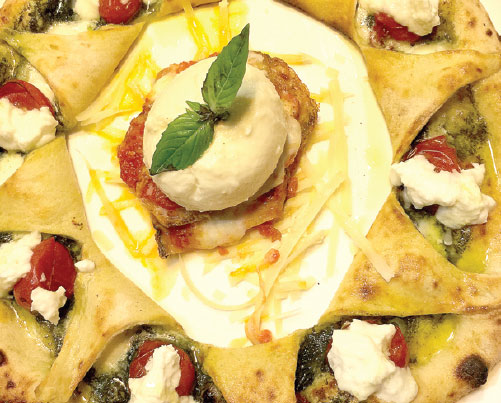Cheese and pizza don't have to burden the stomach
When I heard that Italian food importer Gennaro Miele was marketing a lactose-free mozzarella, I thought he'd gone mad. Sold his soul to the devil. Or maybe been kidnapped by space aliens.
Miele, after all, is the guy who has made a name for himself in China over the past 10 years by bringing in high-end food products from Italy for some of the country's top European restaurants. The soft bufala and other cheeses that he has stashed in his flagship La Pizza restaurant at Shangdu SOHO entice Italian chefs from other restaurants to come over for lunch on Sunday afternoons. And now he's selling ... fake cheese?
"No no no," he says, "it's very good, very tasty."
|
The kitchen team at La Pizza in Shangdu SOHO will substitute lactose-free cheese in any menu item. Mike Peters / China Daily |
So it's just like the cheese with lactose? I ask.
"Not quite," he says. "The texture is different, a little firmer. But the taste is good."
So good, he says, that he's offering to substitute Sassano brand Delattosa in almost any dish on the menu, even though it has meant virtually creating a separate kitchen area for it.
I'd planned to order a pizza that was half lactose-free and half, well, the real stuff, but that's not the way it works.
"You have to keep things totally separate, you can't really be using the same tools, the same spoons for that and the regular dairy, or it really won't be lactose-free," he says. "That's why I only offer it at this La Pizza, where I can personally control it, and not in my other two restaurants."
Similar thinking drives kosher and halal kitchens - you can't mix tools and foods used for those foods with tools and foods used for non-kosher and non-halal foods.
In addition to his flagship restaurant, Miele is marketing the cheese to some Western grocery stores and delis, as well as other restaurants around China that buy foodstuffs wholesale from his importing business.
Miele is quick to note that a product that is lactose-free or low-lactose is still "real" cheese. Long-aged cheeses, he adds, lose their lactose naturally in the process.
"If you're lactose intolerant, your body can't digest the natural sugars in dairy products," he says. "You can reduce lactose by breaking down complex sugars into simple ones as you heat milk above 120 C. One problem is that you lose a lot of nutrients as well as the sugar when you do that." Also, low- and non-lactose milk and cheeses made from them usually taste a little sweeter. Non-lactose milk and cheese products can also be made from soybeans, rice, almonds or other foods, but the taste and nutrition value of these non-dairy products can vary significantly.
However, some people who are not lactose-intolerant might still use such dairy products, he says, because they are easier to digest.
Digestability has always been important to Miele, who pursues that goal in other ways at his restaurants.
Most significantly, he allows the yeast in his pizza dough to "work" for at least 48 hours - and 72 hours midweek when the volume of orders is not as heavy. The yeast action breaks down more molecules and makes a pizza crust easier to digest.
"You can come here and eat as much pizza as you want, and you won't feel so full, so uncomfortable later," he says.
michaelpeters@chinadaily.com.cn



















